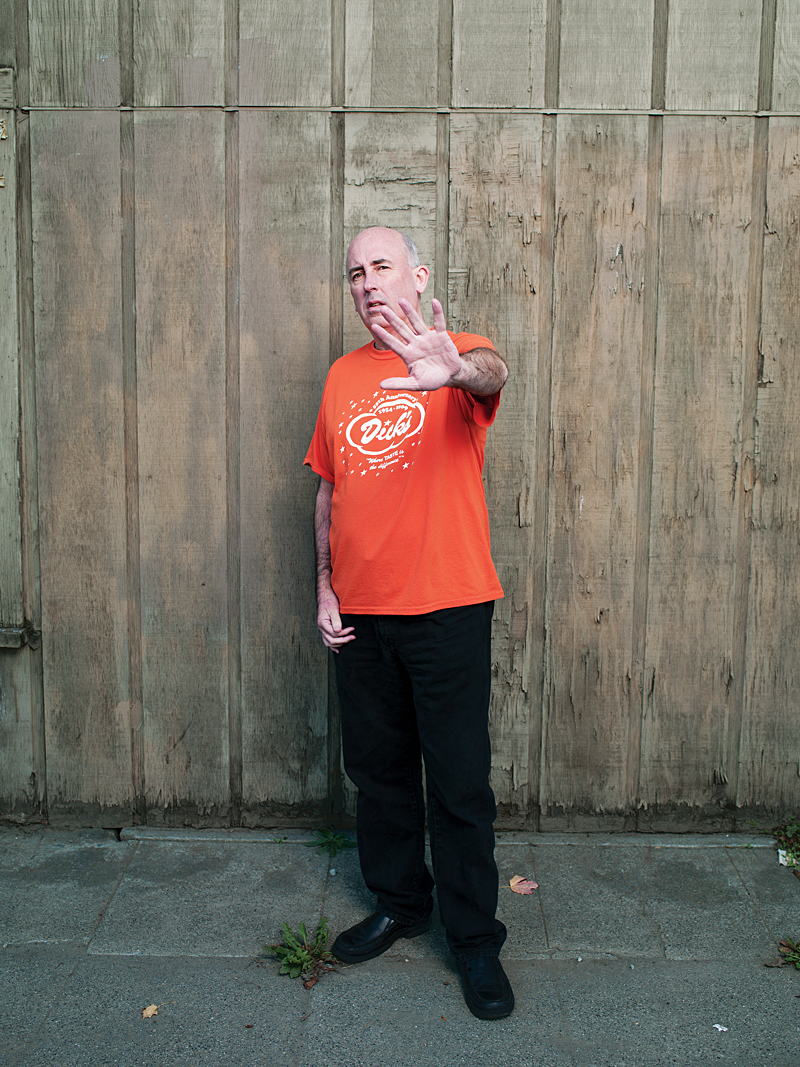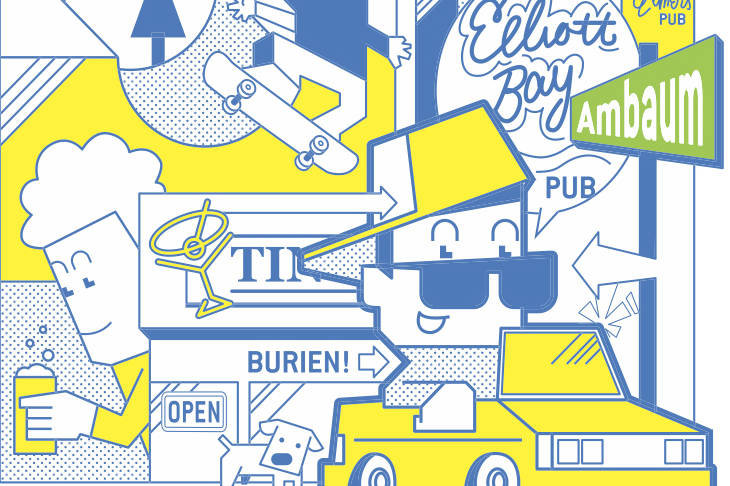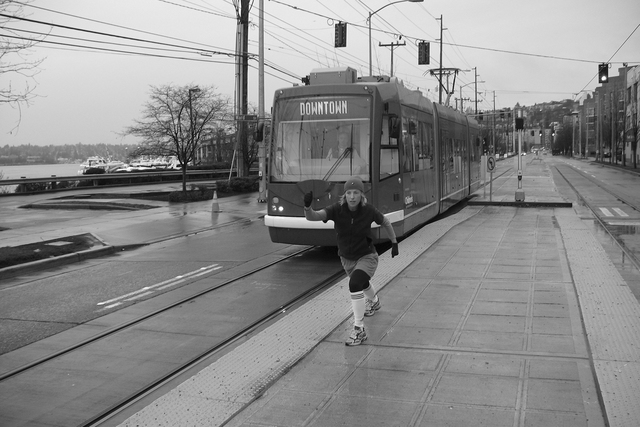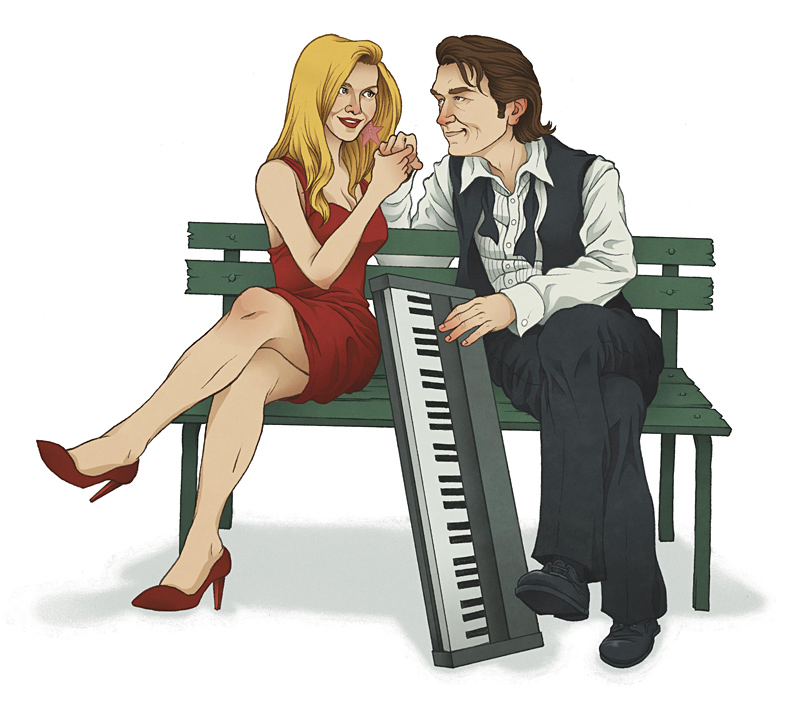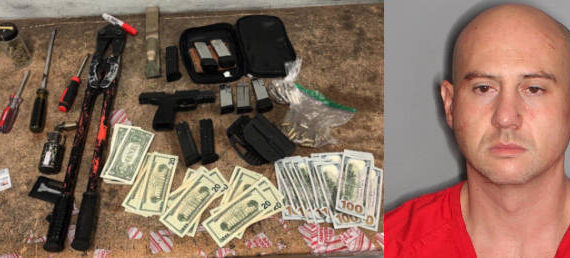Beer and wine flow in the Renton Senior Activity Center’s auditorium, where the Lindbergh High School jazz choir is midway through a sterling rendition of “Fly Me to the Moon.” The crowd is more generationally diverse than the location might suggest. The event at hand isn’t only for seniors; it’s an auction to benefit the Renton Historical Museum.
At a table near the stage sits John Keister, the former host of Almost Live, widely regarded as one of the most successful locally produced sketch-comedy shows—or local shows of any kind, perhaps—in the history of modern American television. Keister, never one to rely on a Men’s Wearhouse palette, is dressed in a black blazer and purple shirt with a diagonally striped tie. It’s been 11 years since the last new episode of Almost Live aired (weekend reruns on KING-5 still win their 1 a.m. time slot), but the 54-year-old Keister looks unmistakably like his lanky self, the top of his head still as shiny as an NBA championship trophy, the remaining hair on his temples a bit whiter for the days.
Keister’s not here to suck down brews or bid on a cruise, he’s here to perform. Not only is he emceeing the auction, he’ll also be delivering a stand-up set in what anyone familiar with Almost Live might consider hostile territory. Back in the show’s heyday, a 15-year run that both predated and outlasted grunge, Keister and his cohorts mercilessly ripped on Renton and its South King County neighbors—most notably, Kent. But then they basically did that to everybody, all but inventing and most certainly cementing a plethora of cultural stereotypes that remain embedded in the region’s DNA.
As the jazz choir files out, Keister rises to the stage and begins a round of local historical trivia, quickly diverting off-script to ask the crowd “where did Renton High School students contract the most communicable diseases?”
“The Loop!” the crowd responds, virtually in unison, in reference to the set of roads which ring downtown Renton’s perimeter.
Keister, who was raised a short distance up the Lake Washington shore in Seward Park and attended Franklin High School, begins his set by acknowledging his lambasting of Renton during his TV tenure, recalling one joke about how the 1990 collapse of the I-90 bridge created “the biggest crisis in Mercer Island history: They had to drive through Renton to get to Seattle. You guys didn’t take that one too well.”
The crowd responds with knowing laughter, giving a formidable former adversary a verbal slap on the back. In fact, since Almost Live ceased production, Keister has cut televised spots promoting Renton’s resurgent civic pride.
“I’m sort of a student of high-school nicknames,” he then tells the crowd. “West Seattle High changed its name from the Indians to the Black Jack Dealers. But Renton High is still the Indians and Franklin is the Quakers, even though there was no nonviolence when I was there. Snohomish High has the whitest student body in the area and they’re the Panthers; Rainier Beach has the blackest and they’re the Vikings.” He says he recently asked a Rainier Beach student about this, who replied that they simply painted the Viking brown, “so he’s Hispanic.”
Keister has clearly made his peace with Renton, but fans of Almost Live might be surprised to find him performing in front of a room full of suburban history buffs for another reason: He should be bigger than this by now. His post–Almost Live accomplishments are hardly insubstantial, but by his own admission, he didn’t envision having to hustle for gigs like he has since the show folded. He should have made it, like his former castmates Joel McHale (The Soup, Community) and Bill Nye, the Science Guy.
Back when Almost Live‘s original host, Ross Shafer, left to take over Joan Rivers’ late-night chair in Los Angeles, Keister, his then-wife expecting twin boys, stood at a crossroads. The quintessential Seattleite, Keister stood pat, and has played a critical role in putting the city on the map. But has Seattle, drunk on self-importance, returned the favor?
Keister was on staff at the University of Washington Daily in the ’70s alongside future Rocket editor and rock biographer Charles Cross; Orange County Register film critic and founder of rogerebert.com Jim Emerson; Tacoma News-Tribune political columnist Pete Callaghan; and Pulitzer winners David Horsey (Seattle P-I) and Evelyn Iritani (Los Angeles Times).
“We all had massively long locks of hair,” Cross recalls.
Upon graduation, Keister went to work at the Seattle Sun, which he describes as “a Capitol Hill hippie newspaper that ran articles about shutting down the Trident Sub base, macramé, and sprouts.” The Sun had an entertainment section dubbed “The Rocket,” which skewed toward more aggressive fare.
“The hippies, mellow as they were, simply could not stand the punks,” recalls Keister, “and eventually ‘The Rocket’ went off on its own. I followed.”
That was 1979. Keister wrote under the pseudonym Johnny Renton, “passing judgment on performers and ridiculing everything else.” A couple years into the gig, KING-TV called, wanting Johnny Renton to do a weekly music segment for the station. Keister told them he couldn’t do the show as Renton, but could do it as Keister. Hence, in 1983, “The Rocket Report, With John Keister” was born on a pre-MTV music-video show called REV, hosted by Heart guitarist Roger Fisher.
Around that same time, KING launched a Letterman-esque local comedy show called Almost Live, which aired at 6 p.m. Sundays and was, as its name suggests, almost live: The studio portion of the show was taped before a live studio audience about an hour before it aired, allowing for only the smallest of tweaks in the editing room. It was hosted by Shafer, who initially struck Keister as “a standard, generic comedian—a ‘sweater comic,’ as we used to say in the clubs.” Shafer was equally wary of Keister, whom KING quickly assigned to work on Shafer’s show.
“At first he was all over the place,” recalls Shafer, currently in the process of moving from Southern California to Denver. “In the beginning, he only got two minutes every three weeks. He’d write his idea on napkins, and they were always pretty half-baked. [But] all my reservations went away when he would take these half-baked ideas and come up with something great. When he wanted to go to Pike Place Market with a camera, we didn’t question him or ask him for a script, and he’d come back with something. He’s very talented; his role got bigger as he found his groove.”
Keister also grew to value Shafer. “I started realizing that I had misjudged him,” says Keister. “I also realized I had misjudged many of my co-workers at The Rocket. They gave me endless shit about being on this stupid corporate show with a vapid, smiling yuppie host. But I began to realize that Ross wanted the show to be a success and was working to make that happen. Over at The Rocket they were more interested in artistically valid failure.”
Here, Keister shares an anecdote about The Rocket‘s fifth-anniversary party. The paper had hired Los Lobos to play, and Keister dutifully showed up early to decorate the hall they’d rented for the occasion. “The party started, and I kept waiting for my friends on the editorial side to show up,” says Keister. “They eventually slinked in very late and just smirked at the whole affair. They were too hip for their own party. I quit shortly after that and went to work full-time for Almost Live.”
Shafer and Keister were like Magic and Kareem, or vice versa. Shafer delivered the opening monologue and interviewed guests, while Keister was the go-to guy for sketches. Casting about for a bigger stage, in 1988 Shafer and head writer Jim Sharp seized an opportunity to go to Hollywood and take over Rivers’ late-night show on FOX. Keister joined them—for a short while, anyway.
“I invited John to come down and be my sidekick (a la Ed McMahon),” says Shafer. “In his audition, he blew the FOX executives away.” Keister was offered the job ahead of such future stars as David Spade (“We had no chemistry,” says Shafer), but politely turned it down.
“When I went down to L.A., that was a couple of the most fun weeks of my life,” says Keister, who now lives in Columbia City. “At the same time, we found out we were having twins. I knew there was no way we could be in showbiz; it would have been a 24/7 proposition.” He then quotes a favorite line from Richard Crenna’s character in Body Heat: “I wasn’t willing to do what was necessary.”
Shafer and Sharp’s run on FOX lasted seven months. Shafer now tours the country as an in-demand corporate speaker, and Sharp holds the title of senior vice president of development for Comedy Central. What would have become of Keister had he joined the Tinseltown fray is a question to be forever unanswered, but Shafer suspects he’d have reached extraordinary professional peaks.
“If John had a work ethic of ‘I’m gonna go out and kill it,’ he would have been unstoppable,” says Shafer. “He could have gone a lot further, [but] he wasn’t driven by that. He’s admitted to me several times that a goal for him would be to be iconic, like J.P. Patches. And I think he might be there. He just loves the [Seattle] region.”
“John made a choice—Seattle’s my home, I have a family, I’m in charge, I love what I do,” adds Sharp. “Which I totally respect; he was having fun and being really creative.”
But upon being named Shafer’s successor as host of Almost Live, it wouldn’t be long before Keister began second-guessing himself.
Keister still regularly performs stand-up, as he did in late September during a warmly received guest set at the Comedy Underground, where he opened for a pair of national headliners. He’s the head writer on a national PBS show called Biz Kid$, a Pee-wee’s Playhouse–meets–Schoolhouse Rock financial-literacy program, produced by much of the same team that created Bill Nye the Science Guy—which is among the largest television productions based in Seattle. He lands the occasional small movie role—as he did in the recent SIFF entry Visioneers, a dark, snail-paced film which starred current alt-comedy darling Zach Galifianakis—and writes plenty of scripts that end up in development purgatory. He’s usually paid for this TV work, often by his old friend Sharp and Comedy Central.
To make ends meet, he emcees events like the Renton fund-raiser and helps with his longtime girlfriend’s interior-remodeling business. She does a lot of restaurants and bars, so Keister is regularly cast as a one-man demolition crew, tearing up vinyl benches and such.
He’s also taught Fundamentals of Scriptwriting at the Art Institute of Seattle since 2005. While the eccentricities of his Art Institute students provide constant fodder for his stand-up act, he says he also “was unprepared for the pleasure I’d get when someone improved” as a writer.
During a class in mid-August, Keister provided his students with the sort of opportunity Hollywood humpers would kill for: a de facto pitch meeting with a development head at Comedy Central. Sharp, who grew up in Tacoma and ran an advertising agency with Shafer before they started Almost Live, was staying at his family’s cabin in Vashon for a couple weeks, and had agreed to drop by Keister’s class. (Keister consistently hires current and former students to work on Biz Kid$, another perk for fledgling screenwriters.)
One student has an idea to do a sitcom about “puberty in space—Saved by the Bell meets Deep Space Nine.” Sharp thinks the idea has promise, but tells the student that he should try and sell it to Nickelodeon. Sharp then speaks of a new show called Workaholics, which began as three webisodes that impressed the network’s execs enough to give the show’s creators $50,000 to shoot a pilot. Comedy Central ended up ordering 10 episodes. “It’s hard getting started in this business,” Sharp tells the class. “Is it harder to do in Seattle? Yes, but it’s not impossible. A lot has changed because of technology. Now it’s more ‘Show me, don’t tell me.'”
In 2007, Keister took a group of his students to San Diego to compete in a national collegiate speed-filmmaking tournament, which was broadcast on the college sports network CSTV. The Art Institute was up against such heavyweights as UCLA, Claremont College, the University of Texas, the University of Illinois, and Chicago’s Columbia College. Michael Cera, now a bona fide movie star after rising to TV prominence as a teen on Arrested Development, was one of the judges.
Each school was given the same script with which to make a five-minute film within 48 hours. Keister’s team selected “the fattest actress available” and plopped her right in a bedroom scene to open Sand Off!, which quickly moves to the beach and features a sand-castle obliterator named Sandy as its antagonist. Keister plays the role of a sideline reporter, and the film is zanily reminiscent of Billy Quan, a popular Almost Live kung-fu parody that Sharp and Keister tried to develop for Comedy Central shortly after Almost Live ceased production. (Sharp was not employed by the network at the time, and their effort failed.)
Against all odds, the Art Institute, in the only year it traveled to the annual competition, prevailed, leaving a multitude of more learned Goliaths in its wake.
Keister faced similarly long odds when he replaced Shafer as host of Almost Live in 1988. For one, the suits at KING wanted Keister to wear a suit. They also wanted the format to remain static, which meant Keister had to chat one-on-one with guests, something he wasn’t very good at.
Stressed out by the show’s struggles and the rigors of raising twin toddlers, Keister lost so much weight—30 to 50 pounds, by his estimate—so quickly that people began speculating (falsely) that he’d contracted AIDS, at the height of the epidemic. “I was like, ‘Great, I didn’t go to Hollywood and now the show is going to spiral down,'” recalls Keister.
“Why it wasn’t canceled is somewhat miraculous,” says Pat Cashman, who wrote and performed on the show at the time and stuck around until its end. “I remember they brought in a new general manager. He was very big and bodacious, and decided it would be a good idea to have the whole station gather in the studio and meet him. They asked me to emcee, so I introduced him. He said, ‘What is the name of that show you guys do: Almost Dead?’ I said, ‘I guess that’d be up to you, wouldn’t it?’ That got a laugh. Then the time slot was switched, and it rose like Lazarus.”
Almost Live came to occupy its signature 11:30 p.m. Saturday time slot, in Keister’s second season as host, in an unprecedented coup. Despite its shortcomings, Almost Live was so popular among KING employees that station brass decided to ask NBC if it could air Almost Live at 11:30 and delay Saturday Night Live, the network’s flagship comedy program, to midnight. They approved the arrangement on a six-month trial basis. Then, as Keister says, “Saturday Night Live tanked, and we won a big award [being named best local show in America by the National Association of Television Programming Executives], so the trial was allowed to continue.”
Almost Live also benefited from the addition of Bob Nelson—a brilliant writer and deadpan performer who would later team up with Keister on the short-lived John Report With Bob on KIRO—and a switch to an all-sketch format. This played directly to Keister’s strengths, and also allowed the show’s whip-smart local satire to take center stage. “Keister has that great knowledge of comedy,” says Nelson, “but I can’t think of a guy who knows more about Seattle. He’s professorial in a way. I think that made the show.”
Benefiting from the “ultimate beer-and-pizza demographic,” as Keister put it, the reconceived format was a smash with viewers and advertisers alike. While much humor was local, there were enough broader sketches that Comedy Central aired repackaged episodes of the show—which included a fair amount of new material as well—for three years in the ’90s, and Sharp tapped into the cast’s catalogue for a show called Haywire that aired nationally on FOX for one season.
“At the end of the day, the funniest stuff came out of Seattle, in spite of the fact that we had a full staff [in L.A.],” says Sharp.
Just then, Seattle, long considered a remote fishing town in a forgotten corner of the country, became a star in its own right. Starbucks, Microsoft and grunge each went global very early in Keister’s tenure as host. All told, Almost Live enjoyed a 15-year life-span, airing its final episode in 1999—coincidentally the same year the WTO riots convinced many that Seattle wasn’t quite ready for prime time.
Graham Clark and Dave Shumka, hosts of the hit podcast Stop Podcasting Yourself, have made the trip to Seattle from their British Columbia home to create their newest edition live inside the Vera Project during Bumbershoot. They’ve invited Keister to join them onstage. This is not by accident: Almost Live remains huge in western Canada, where it’s long been broadcast.
Entering a packed house at 1 in the afternoon, Keister has no prepared bit, and very little clue as to what will be asked of him by the young Canadian duo. When the topic of enhanced security at the Canadian border comes up, Keister quips that the true domestic terrorists are “hippies from Eugene who aren’t even allowed to pump their own gas. That’s the border we should be worried about.”
He then jokes about how strip clubs are so ubiquitous in Canada that he went to one where hockey was being shown on a tiny television set in the corner while a comely dancer slithered down a pole, “and everyone was watching hockey.” Moving east, he tells Clark and Shumka that “there’s nothing indigenous to Bellevue. It’s one giant franchise; they don’t even have a Dick’s. Bellevue is currently Dickless.”
While some of Keister’s jokes have discernible punch lines, most are free-ranging anecdotes drawn from his everyday life. He’s the opposite of a sweater comic, and a trailblazer for the alt-comedy wave that rose from Almost Live‘s ashes. (Fittingly, the local collective People’s Republic of Komedy was the sponsor of this Bumbershoot event.)
A week and a half ago, Central Cinema screened Seattle Komedy Dokumentary, a new film by Clint Berquist that focuses mainly on PROK’s emergence. Snippets of interviews with Keister, portrayed as a sort of godfather to the scene, are peppered throughout, yet he receives top billing in the opening credits. And he’s accepted numerous invitations to headline PROK events, their embrace of him a far cry from the shit he used to catch from his Rocket cohorts and other scenesters who felt that his involvement with KING meant he’d sold out.
“I don’t know if it’s the result of Comedy Central [airing the show in the ’90s], but [Keister] is sort of a nationally recognized character,” says PROK leader Kevin Hyder. “People all over the country are, like, ‘The John Keister is doing your show?’ He’s not a nationally touring comedian, but he was the comedic voice of a very important place at a very important time, and he brought it to the nation.”
The PROK comics, Keister says, “don’t have any beef with me. They’re inspired by me and want me to perform with them. I’m flattered, and the venues they perform at draw a really smart crowd.”
When Keister performs live, youngsters are intrigued by the fact that he’s capable of working blue, a reaction similar to that when Bob Saget, known best for squeaky-clean turns in Full House and America’s Funniest Home Videos, outs himself as one lewd hombre in The Aristocrats and on Entourage.
“He can be really dirty, which you don’t see on TV,” says local comic Paul Merrill. “You see how edgy and raw he can be. He’s got this clean-cut image, but once he’s uncensored, he can really let loose. I performed with him three or four months ago (June 2, to be exact) at Chop Suey. He headlined and did a great job. That can be a tough, hipster crowd, and he totally killed.”
Old Almost Live episodes can be found all over YouTube. But if the show restarted production today, Who Would John Diss?
The high-fivin’ white guys would take on a darker tenor, he hints, with Kerry Killinger leading a group of reckless mortgage brokers through the streets of Seattle, overexuberant to a fault. “We did that bit to answer the question: What if people lived their entire life like they do in beer commercials? The high-fivin’ white guys took over WaMu.”
The Senate race between Patty Murray and Dino Rossi would get sent up for sure. Keister’s had his fill of their negative ads, and considers Rossi a buffoon for suggesting that votes from convicted felons cost him a gubernatorial election. “I’ll grant you that most convicted felons are Democrats,” Keister theorizes. “But convicted felons who vote are Republicans.”
Of skinny-jeaned hipsters, Keister says, “I hate hipsters, probably because I did enough time as one myself.” But bicycle commuters who double as loyalists to the Eat Local movement? Now his ire’s fully erect. “It’s really amazing to me, these guys who ride tandem down Lake Washington Boulevard so nobody can get by. They’re really proud that they’re doing that. I think that’d be a target: super-entitled people. I think the city takes itself way too seriously.”
As for taking aim at neighborhood or suburban stereotypes, that’d be tougher, as Seattle’s geographic delineations are more culturally obscure than they were before gentrification blurred all differences. “The Ballard of Almost Live is like the Paleolithic era,” remarks Cross. “There aren’t senior citizens driving around with seat belts hanging out of their Chevy Cavaliers anymore.”
Adds Keister: “People started to move to Seattle who had more of an allegiance to others of their kind than where they lived. It’s always dangerous when you can put a destination with an idea. We were suddenly this place you move to be successful, and that precipitated a bunch of double-edged cultural swords.”
Was Almost Live a casualty of Seattle’s success? No, says Keister, who lays the show’s demise more at the feet of media consolidation and the subsequent gutting of original local programming by network television, save for PBS. Eleven years on, while his name might not be in lights, he nurses a beer contentedly at the Athenian Inn, looking back at the fork in the road he confronted in ’88.
“If I had gone to L.A. with Ross, I’m pretty sure Almost Live would have stayed a talk show and faded away,” he says, gazing out on a sun-soaked Sound. “I don’t know what would have happened to me in L.A., but I think that Almost Live was the right decision. The thing is, everybody in showbiz wants to be someone else. You always want to be further along than you are.
“There’s not a day that goes by where people don’t come up to me and talk about some Almost Live bit that made them happy,” he adds. “We defined a sort of comedic language for this area. Whether people are conscious of it or not, they use it.”
While Keister keeps abreast of current events, his comedic reference points still tend toward Almost Live‘s later years. Yet this hasn’t seemed to diminish his popularity among young adults, who seem to have a ravenous appetite for the Seattle of their formative years, and who watched Keister and his cohorts satirize it so shrewdly beneath the rabbit ears. Says the 37-year-old Hyder, who moved to Seattle from Spokane when he was 14, and who invited Keister to headline the Chop Suey gig: “I thought he’d be sort of antiquated and from an era before us. But when he came and did our show, he just blew our mind. He’s an amazing storyteller, and completely relevant.”
Then there’s 30-year-old Andrew Chapman, a respected local rocker who most recently played in The Keeper. One would expect Chapman to bow at the altar of Soundgarden when explaining his adolescent affinity for the city. But that’s simply not the case.
“When people talk about grunge and these things that represented Seattle, I always thought that was kind of bullshit, because it was just a few people making this noise,” says Chapman. “But if you watched Almost Live, you got a better feel for the class tension and the sense of neighborhoods. I remember going to Bedazzled Discs in the U District and seeing John Keister on their poster. That gave them instant credibility.”
In other words (Cross’): “John just is Seattle.”
